Take a look at the modern home. Do you see it? Look a little closer. Yep, that's a kegerator. Just as wine refrigerators used to be considered a specialty appliance and are now as common as the microwave, kegerators have quickly become a standard built-in appliance for many home kitchens, wet bars and outdoor entertainment areas.
Traditionally, kegerators were thought to be only for dispensing kegs of beer, but many other beverages are now available by keg. Kegerators are now available to dispense your favorite beer, wine, mead, cider, cold brew coffee, soda, kombucha, sake, water, sparkling wine and basically anything you can put in a keg. If you recently started brewing beer or making wine, a kegerator can showcase your creations and eliminate the hassle of bottling. With so many beverage choices, kegerators have become a requirement for most homeowners and higher beings.
Reasons to Buy a Kegerator
Beer... It's that one little word that sends a million thoughts and emotions down your spine. It is the social glue that we look forward to at the end of a long day. We dream about it, we talk about it and we have always hoped for an endless supply of it. Whether you are a beer geek, wine nut or just a fan of fizzy water, a kegerator can save you some serious time and money.
It is probably a dream of yours to have cold beer flowing in your home, but aside from the obvious reason - that it's just plain cool - there are practical reasons for buying a new kegerator or installing a kegerator kit in an old refrigerator too.
1. Money Saved
Owning a kegerator is like bringing the pub to your home. It is a small refrigerator that can hold an entire keg of beer. The beer stays fresh for almost two months and can save the beer drinker an extensive amount of money.
2. Sophistication
A kegerator has class. They are sleek and beautiful. They are the ultimate conversation piece for a holiday party or sports gathering. Your guests will walk through the door and enter into your kitchen/ bar area, seeing this mysterious yet intriguing device and be drawn to it like a cat to a bag.
3. Less Mess
If you are tired of all the bottles and cans being politely deposited to the nearest living room table for discard, then you will be amazed at the amount of "trash take-out" a kegerator will save you. No more embarrassing walks to the curb with a trash bag full of clinking beer bottles and the neighbors looking over at you with judging eyes.
4. Safety
Safety is another huge benefit to owning your own kegerator. You can stay at home and not drive around intoxicated after a night at the local bar. You can call your friends over to your house and have your own pub night.
A Look at the Different Types of Kegerators
There are two major kegerator configurations to look at. The beer kegerator and the wine kegerator. The major differences between the two are the gas and fittings used to dispense. CO2 gas is used to dispense beer, mead, sake, cider, sparkling wine, soda, sparkling water and kombucha. A mix of nitrogen and CO2 called "beer gas" is used to dispense still wines, water, sake, cold brew coffee and cocktails.
Kegerators come in many styles. Sizes, finishes and the accessories are all customizable and they can be built into counters, they can stand free, sit on countertops, live outside or be converted from an old refrigerator. Kegerators come in residential grade models or commercial grade models. Heavier insulation, thicker wall metals and security features are found in most commercial kegerators.
Freestanding Kegerators
The most common style kegerator on the market. These models are ideal for those who wish to have kegged beverages at home but don't want to make the investment into having a permanent home bar. Freestanding keg refrigerators are mobile and usually have rolling caster wheels for pushing into a garage, poolside, or just to the end of a kitchen island or bar.
For commercial applications, a free-standing kegerator is useful for catering and wedding businesses. Bars and restaurants use them for temporary outdoor events or off-site festivals.
Kegerators.com provides a free comprehensive feature comparison chart for the most popular freestanding kegerators.
- PROS: Affordable. Freestanding kegerators are also portable, giving you the freedom and flexibility to move the unit around the home or business. This especially becomes useful when off-site dispensing is needed. They are less expensive than other more specialized models and have a compact small footprint.
- CONS: Usually made with less durable materials and their compressors tend to be loud.
Built-in Kegerators
These kegerators are best utilized when building them into cabinetry and when a draft tower is needed on a countertop. Built-in kegerators are designed with specialized ventilation, usually from the front toe kick, but some built-in units have cooling fans mounted near the rear compressor. You will find these kegerators are a little more expensive than free-standing units due to the specialized venting configuration.
Sometimes called "build-in ready", these units do not need rolling casters or glass guard rails. The air tank will be mounted on the inside and some models can be fitted with custom cabinet door faces to match your existing cabinet style.
- PROS: Blend in well with modern kitchen and bar design. A draft tower mounted on a countertop adds a level of class in comparison to a freestanding unit.
- CONS: Expensive. Once you build-in a kegerator it is not easily removed, so they have no portability.
Outdoor Kegerators
Outdoor rated kegerators, also known as wet-rated kegerators, are perfect for patios and other damp areas. Use outdoor kegerators anywhere in your home that might be exposed to water or high levels of humidity. Patios and pergolas are some common locations where people use these products. All wet location kegerators are UL rated and most feature thicker insulated walls. They also come in efficient Energy Star varieties. Wet-rated outdoor kegerators are manufactured with rust-resistant exterior materials and stainless steel towers and faucets to endure rain, snow, ocean spray, or any kind of water.
Kegerators with damp or wet ratings are available in a number of widths, styles, and finishes to complement your style. When designing your outdoor kitchen or bar, think about incorporating an outdoor kegerator.
- PROS: Weather resistant and available in freestanding or built-in models. Brings beverages closer to the outdoor party.
- CONS: Expensive. Though weather resistant, outdoor storage covers and insulating tower covers are recommended in extreme hot and cold weather.
Professional Grade (Commercial) Kegerators
Commercial kegerators are the large keg refrigerator units you often see at a bar or restaurant. They come in many sizes and are built with extremely durable materials. They have a large keg capacity (some will hold up to 5 kegs).
Choose from single or multiple draft towers to dispense multiple beers using the same refrigeration space. The larger units have additional space for storing bottles, cans or other bar related supplies.
Due to the constant use these kegerators endure they are outfitted with some features not usually found in residential kegerators like steel floor plates, door alarms, locks, interior lighting and draft tower cooling fans. Some of these commercial keg dispensers can get quite large, as well as pretty costly, but they will last much longer than a home kegerator.
- PROS: Long warranties. Professional grade materials and spacious storage capacities.
- CONS: Expensive.
DIY Kegerator
You can make your own kegerator from a variety of different freestanding refrigerators and freezers with a kegerator conversion kit. For just a few hours of your time you can have your own multi-keg draft system at home.
If you have an unused refrigerator, all you need is a conversion kit and a few tools to put it all together. You can purchase conversion kits for mounting taps in the door of a refrigerator, on top of a small dorm (apartment) refrigerator, or you can build a keezer and mount taps in the wooden collar.
There are many places you can source a used refrigerator or freezer like Craigslist or eBay, but don't forget about used items on Amazon or apps like LetGo. You also can also check online scratch and dent and open box stores.
- PROS: Very affordable when you build it yourself.
- CONS: May not be the prettiest belle at the ball. No warranty.
Countertop and Mini Kegerators
A space and dollar saving choice for those wanting small amounts of draft beer available at home. The kegs for these units vary in size and can be sourced from your local grocery store or your local brewery.
A great feature with mini kegerators is their portability. You can take these units practically anywhere you have power. Great for RV's, boats, and golf carts. These units have a very small footprint, so they don't get in the way.
Mini kegerators are fairly inexpensive and have a limited selection of 5L kegs available. The most common are imports like Heineken, New Castle and Warfsteiner. You can also fill these 5 L mini kegs with home made beer or have them filled by local breweries.
- PROS: Compact, very affordable and portable.
- CONS: Limited keg selection and capacity.
Features to Consider When Buying a Kegerator
When shopping for a new kegerator you may not take note of something as simple as the door or the finish of the handle, but there are a few features to look at that might make a big difference once you get the unit home.
Doors
Kegerator doors are the gateway to the chilled beverage that waits inside. They can either blend into your surrounding design or add an exciting pop of color to a room. Take notice of the finish, extra features and handle styles to get the look you are going for.
Door Finishes

Black
The basic door most kegerators come with and is a black wrapped or painted metal door.

Stainless
Classic brushed stainless steel doors match most other standard stainless steel appliances.
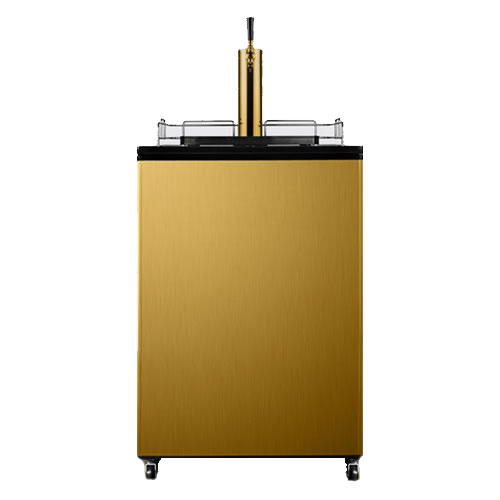
Brass
The boldness of brass doors adds some elegance with a splash of gold.

Diamond
A tough textured stainless steel finish most commonly found in garages and workshops.
Door Features

Reversible Door
Some kegerators feature a reversible door for a left or right handed swing.
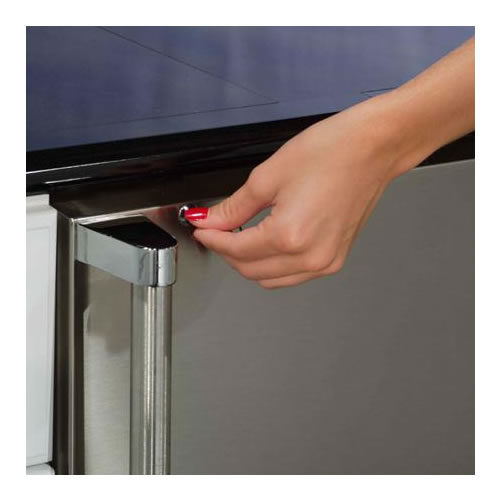
Door Lock
An integrated door lock adds a level of security to your kegerator.
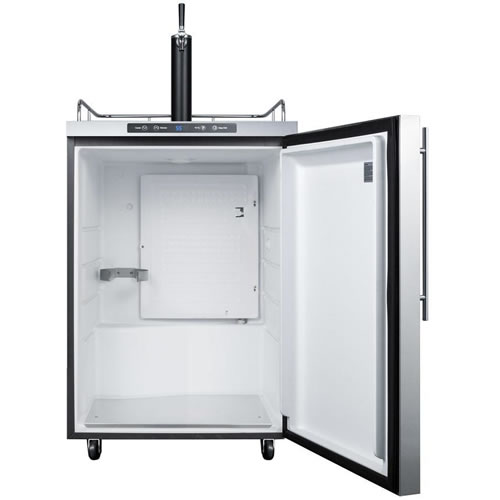
Door Alarm
Reminds you to close the door after 5 minutes if the door is left ajar.
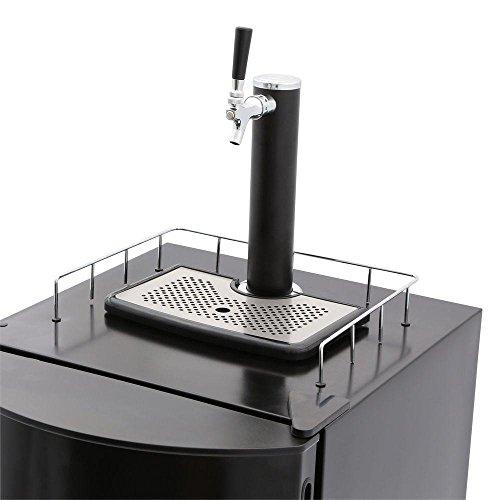
Curved Door
A contoured door that is molded to fit the shape of a full sized (half barrel) keg.
Door Handle Styles
Many home kegerators have molded pull handles either on the top or side of the door. As you venture into the more designer style kegerators with stainless steel finishes you will see a variety of options. Choices include horizontal or vertical pull bars and towel holding bar rails. Commercial kegerators usually have tab style door pulls mounted on the top of the door for easy access.
Panel Ready Doors
Another kegerator door feature you will find is called a panel-ready door. This style of door allows you to mount a custom cabinet panel directly to the face of the kegerator door to match the other cabinet door panels.
Most of these door frames are stainless steel and allow you to mount a panel over the front for a custom look that blends into your own cabinetry design.
Worktops
Residential kegerators are normally topped with a painted MDF or HDF wood. In a home environment this is more than sufficient, but in high traffic areas like bars and restaurants you will find stainless steel worktops. The solid steel worktop can handle the bumps and breaks of glassware better. On free-standing units, stainless steel guardrails surround the back and sides of the worktop to keep glassware from slipping off.
Drip Trays
Choices of drip trays range from plastic to solid stainless steel. Obviously stainless steel lasts longer and can be put into a dishwasher without concerns of it warping from high heat like the plastic versions. To drain or not to drain, that might be your question.
Drip trays can come outfitted with a ported drain hole. This drain can be run directly into your sink's drain plumbing so you never have to deal with pouring out spills from the drip tray. Some drip trays drain into a special bottle to collect spills that can be dumped and washed out periodically.
Integrated drip trays will sit flush with the worktop and some feature glass rinsers and drains.
Special Ratings
You will see many different rating scales that each kegerator manufacturer has achieved to make their units more safe or energy efficient. The following are the most common ratings and their meanings.
- Outdoor Rated Kegerators - Meaning that the kegerator has been designed to maintain stable temperatures in an outdoor environment, but it does not mean it is fully weatherproof. Special attention is given to seal off electrical components from moisture and reduce the risk of electrocution. Almost all outdoor kegerators are made from stainless steel thanks to its ability to resist rust in wet environments. However, stainless steel can still rust under the worst of conditions. And, not all stainless steel is made with the same level of rust-resistance. Look for 304 stainless steel.
- Energy Star Kegerators - Energy Star is an international standard for energy efficient consumer products. Currently the Energy Star program does not certify kegerators as ENERGY STAR, so if you see a kegerator listed as being Energy Star Rated this is only for the refrigeration unit and not the other components of the unit.
- UL Rated Kegerators (Underwriter's Laboratory) - To be able to list a kegerator as UL listed or rated special safety requirements must be passed and are based on UL's published and nationally recognized Standards for Safety.
- ETL Listed Kegerators - Similar to a UL Rating, kegerators that are ETL Listed have been tested at an ETL laboratory and found to meet all applicable Standards for Safety published by relevant NRTLs.
- CE Rated Kegerators - A CE marking on a kegerator is to show that the product complies with the essential requirements of the relevant European health and safety and environmental protection legislation.
- NSF Rated Kegerators - A non-profit organization that serves to develop consistent national standards for food safety. When a kegerator is NSF certified this ensures that the kegerator has been tested by one of the most respected organizations in the food-service industry.
Tower and Tap Configurations
Home kegerator draft towers typically come in single, double, triple or quadruple configurations. Most residential keg refrigerators have a maximum capacity to hold 4 slim or homebrew style kegs. You can get draft towers with many more taps and use a larger commercial style keg refrigerator or route the beverage lines back to a main walk-in keg fridge.
Tower Shapes

T Style or Pedestal
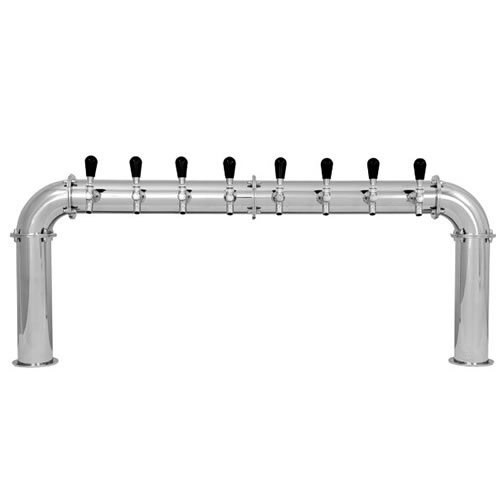
Double Pedestal or Pass

Post or Column
Elbow Shanks
Tower elbow shanks can come in a few different styles. Some are made as a solid piece while others use multiple parts and gaskets that will need to be replaced over time. Take note of the materials use in the elbow shank. Plated brass is the most common due to its low cost for manufacturers, but a solid stainless steel elbow shank is preferred for longevity.
Tower Mounts
Some draft towers now come with quick twist mounts, so no tools or screws are needed for installation. Most draft towers you will see are mounted to the worktop with four screws and installed with a provided gasket between the tower and worktop.
Tap Materials
Chrome & Brass Faucets
Usually a brass body coated in chrome plate. Chrome plated faucet taps are less expensive than stainless steel, but they will chip and rust over time. Chrome is a good solution when price is the determining factor.
Stainless Steel Faucets
Stainless steel faucets are more corrosion resistant and will last much longer than brass and chrome faucets. Because stainless steel faucets are less susceptible to wear and tear they are less likely to chip and add unwanted off flavors to your beverage.
Cooling
The kegerator cooling system is vital to the successful dispensing of your kegged beverage. Today's home and commercial kegerators offer a variety of cooling features that can make chilling your favorite beverages more efficient and delicious.
- Temperature Control - When it comes to temperature control, you have two options. Manual thermostat temperature controls are usually in the form of a rotating knob with settings from 1-10 or cold to hot. You won't have precise temperature settings with a manual control. Digital temperature control gives you an LCD display of the temperature and can be programmed to an exact temperature setting.
- Temperature Range - Temperature ranges vary per kegerator brand. The cooling technology, insulation and wall metal thickness will determine how well a unit can cool and maintain steady temperatures. Most will cool down to the low 30s F and some units have dual temperature zones for holding separate temperatures when two different beverages are being dispensed.
- Auto Defrost - Most kegerators have auto defrost built-in. Some of the less expensive units on the market skip this feature, requiring the owner to unplug the unit and defrost the kegerator whenever ice build is noticed. Products to reduce the humidity levels inside a kegerator are available and can greatly reduce ice accumulation on cooling coils.
- Deep Chilling - Deep chilling, also known as quick chill or turbo cooling is a feature offered in some kegerator units that will quickly cool down your keg. Once the button is pressed, it kicks the compressor into overdrive and sends it back into regular cooling mode when pressed again or after the desired temperature is reached.
- Tower Fan - To minimize foaming, many kegerators are equipped with fans and a tube that runs up into the draft tower called a tower fan. The fan forces cold air up the tube and into the draft tower keeping the draft tower and kegerator chilling areas at the same temperatures.
Gas and Air
Most residential kegerators are outfitted with a 5 lb. CO2 gas air tank. They are always shipped empty and must be filled at a local CO2 filling station. In less expensive units you will find a smaller 2.5 lb CO2 air tank. They work just the same as the larger tanks, but they will need to be filled more often.
CO2 is the most common gas used to dispense beer, sparkling wine, cider, mead, soda and kombucha. To dispense (still) wines or cold-brew coffee you will need a nitrogen gas tank.
An interior tank mount shelf is found in most residential kegerators. The interior shelf raises the gas tank and regulator gauge out of the way of the keg for easier storage. Some kegerators have an option to mount the tank on the back of the unit. Mounting the tank on the outside will free up more space inside the kegerator for kegs, glassware and bottles.
Single gauge regulators are included with most air tanks and show the current PSI setting. Double gauge regulators are sometimes included and also show the remaining gas left in the tank. Secondary regulators can be added and are ideal for use when dispensing multiple kegs off the same CO2 tank at different pressures. Air distributors (splitters) are included in multiple tap kegerators and split the gas line for use with multiple kegs.
Air line tubing is typically included with your kegerator and is made of 5/16" vinyl. There are upgrade kits available with PVC Free Gas Line Tubing as an alternative.
Keg Couplers
The keg coupler connects directly to a keg and allows gas to be pushed in while a beverage gets pushed out. D style (American) Sanke beer couplers will fit the most commercial (half barrel) kegs produced in the U.S. U style keg couplers are required to dispense European (import) kegs. Homebrew style disconnects come in ball lock or pin-lock types depending on the keg being used.
Warranty
Kegerator warranties will vary from 90 days to lifetime. Parts & labor and compressor warranties can all be different time frames, so make sure you read the details of the warranty carefully. Commercial kegerator warranties can be many years to a lifetime, but most companies won't honor the warranty if the unit is used for residential use.
Extras
Home and commercial kegerators have many different extras and add-ons that can drastically affect pricing. Manufacturers add features to try and differentiate their brand from the competition, but make sure those features are actually something you will utilize.

Interior Light
Illuminate the kegerator interior for easier swapping out kegs and air tanks.
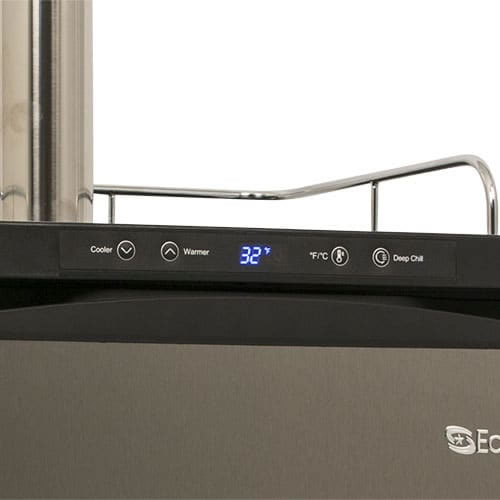
Digital Display
Always know your current keg temperature with a external quick-read visual LCD display.
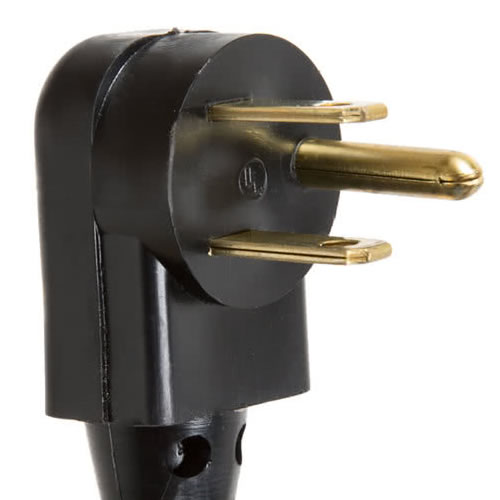
90 Degree Power Plug
Save space and allow a kegerator to be pushed closer to a wall with an outlet directly behind it.
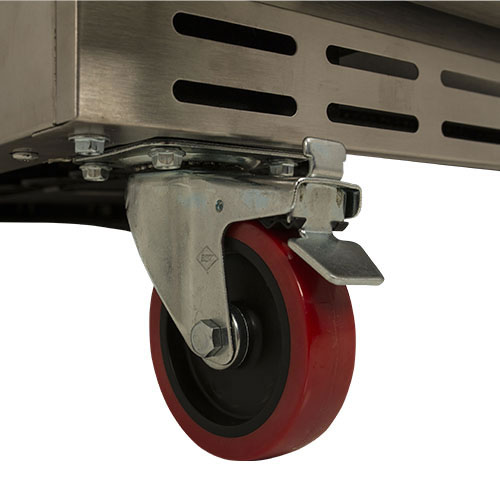
Locking Casters
Anchors a kegerator on uneven ground to prevent it from rolling around.
What's Needed
The vast majority of kegerators will come with all the necessary dispensing equipment, but some companies will exclude these required parts in order to get their prices down. Besides the kegerator itself, here is a full list of items you'll need to dispense a kegged beverage:
- Keg Coupler
- Regulator
- CO2 Tank
- Beer & Gas Tubing
- Draft Tower and Faucet
- Elbow or Straight Shank
- Tap Handle
- Keg
- Spanner Wrench
- Cleaning Kit
Time to Decide
You made it this far. You never knew there were so many things to consider when buying a kegerator did you? Don't worry. Just make sure you stay mindful of all the finishes, features and add-ons when drooling over that 4 tap kegerator for the garage. Enjoy whatever beverage you choose to pour responsibly and always remember to have fun. That's the whole point right?
Cheers!
Komos
 Summit
Summit
 Beverage-Air
Beverage-Air
 DCS
DCS
 Marvel
Marvel
 Perlick
Perlick
 Bull
Bull
 Avanti
Avanti
 Danby
Danby
 CM Becker
CM Becker
 Continental
Continental
 Fagor
Fagor
 Cal Flame
Cal Flame
 Twin Eagles
Twin Eagles
 Fire Magic
Fire Magic
 GrowlerWerks
GrowlerWerks
 Hestan
Hestan
 Igloo
Igloo
 True
True
 Intertap
Intertap
 Kegco
Kegco
 Keggermeister
Keggermeister
 Koolatron
Koolatron
 KegLand
KegLand
 Krowne
Krowne
 Krups
Krups
 Lynx
Lynx
 Maxx Cold
Maxx Cold
 Micro Matic
Micro Matic
 Midea
Midea
 Nor-Lake
Nor-Lake
 Nostalgia
Nostalgia
 Arctic King
Arctic King
 Synek
Synek
 Taprite
Taprite
 Turbo Air
Turbo Air
 UBC Group
UBC Group
 Value Series
Value Series
 Versonel
Versonel
 VinoTemp
VinoTemp
 New Leaf
New Leaf





























